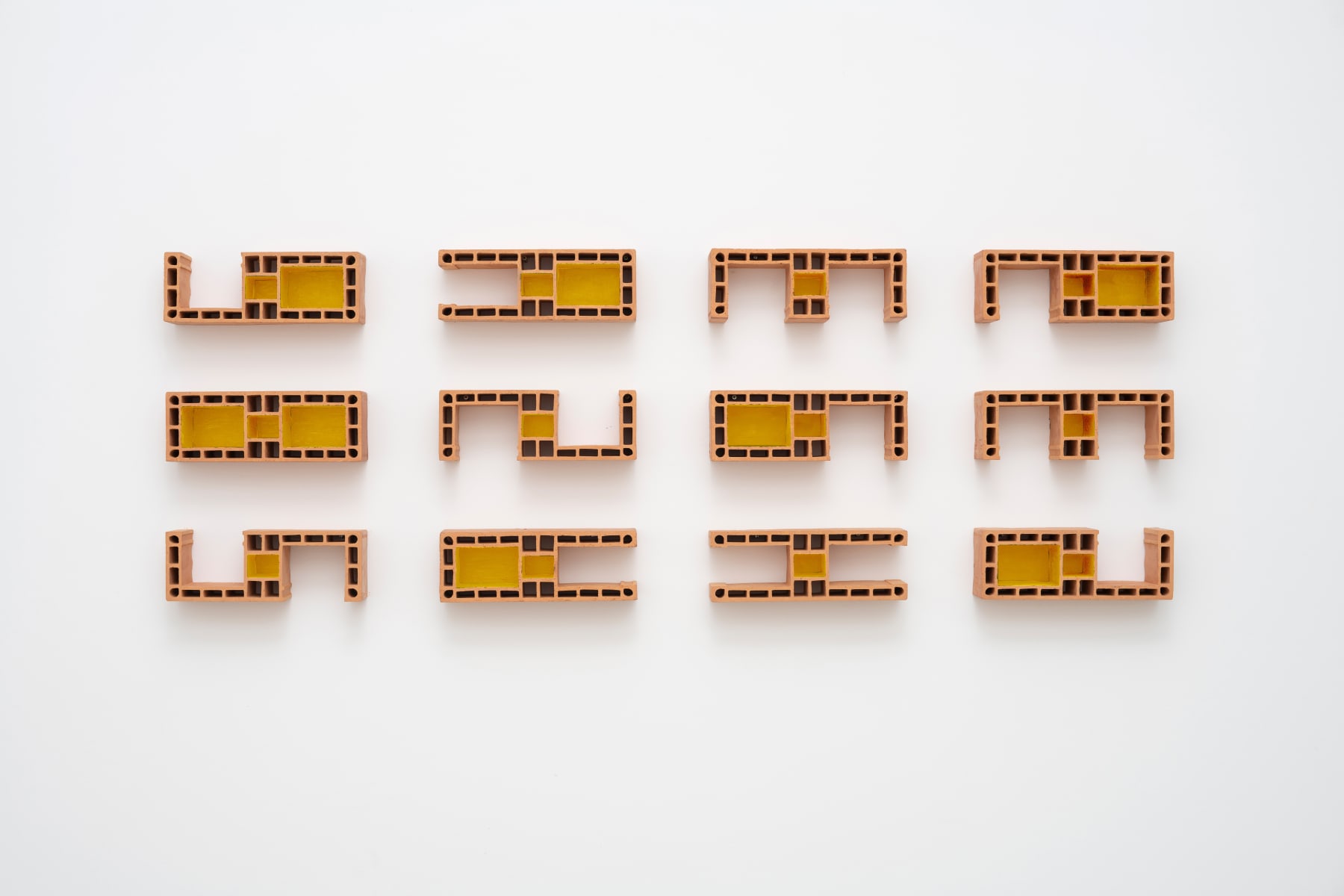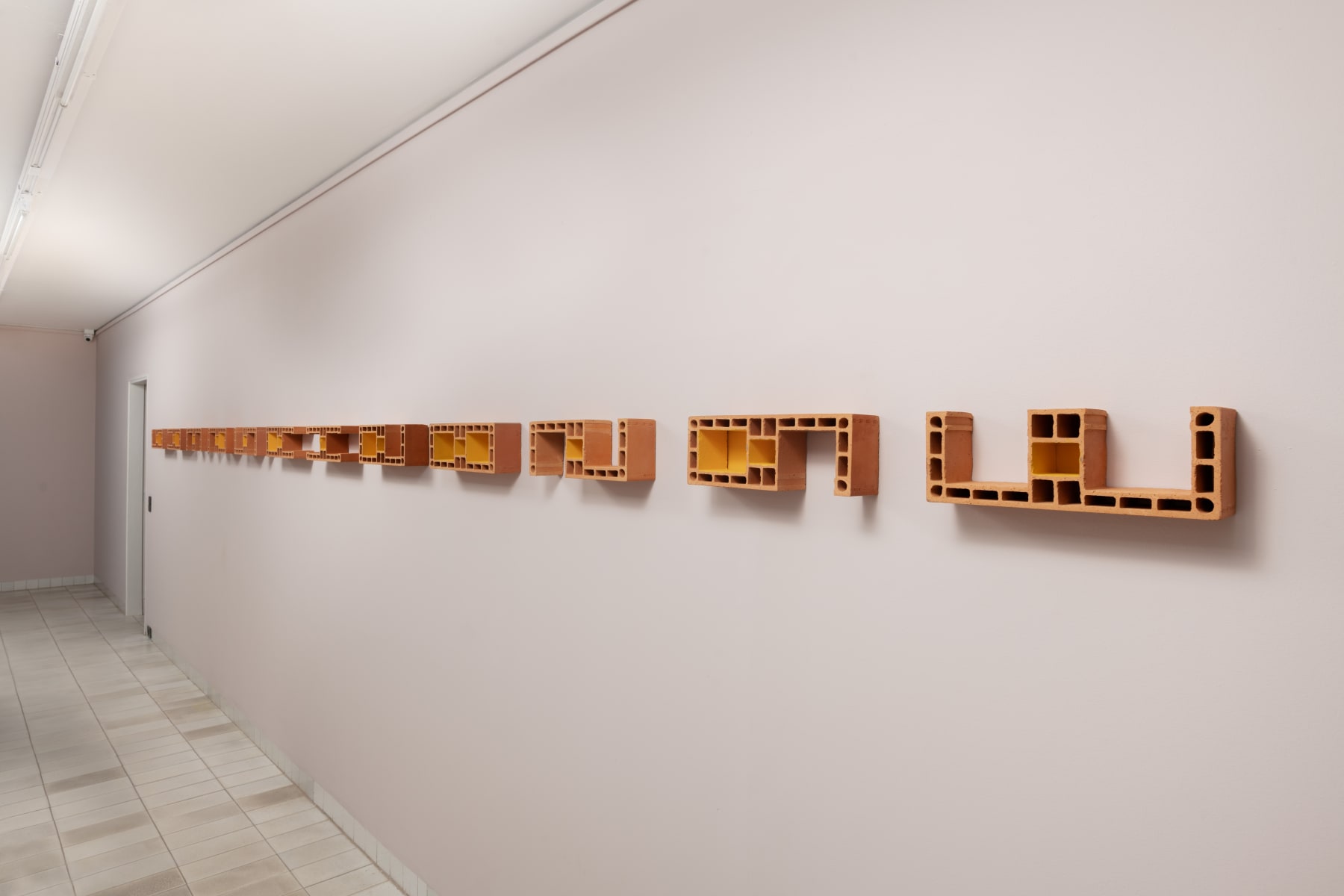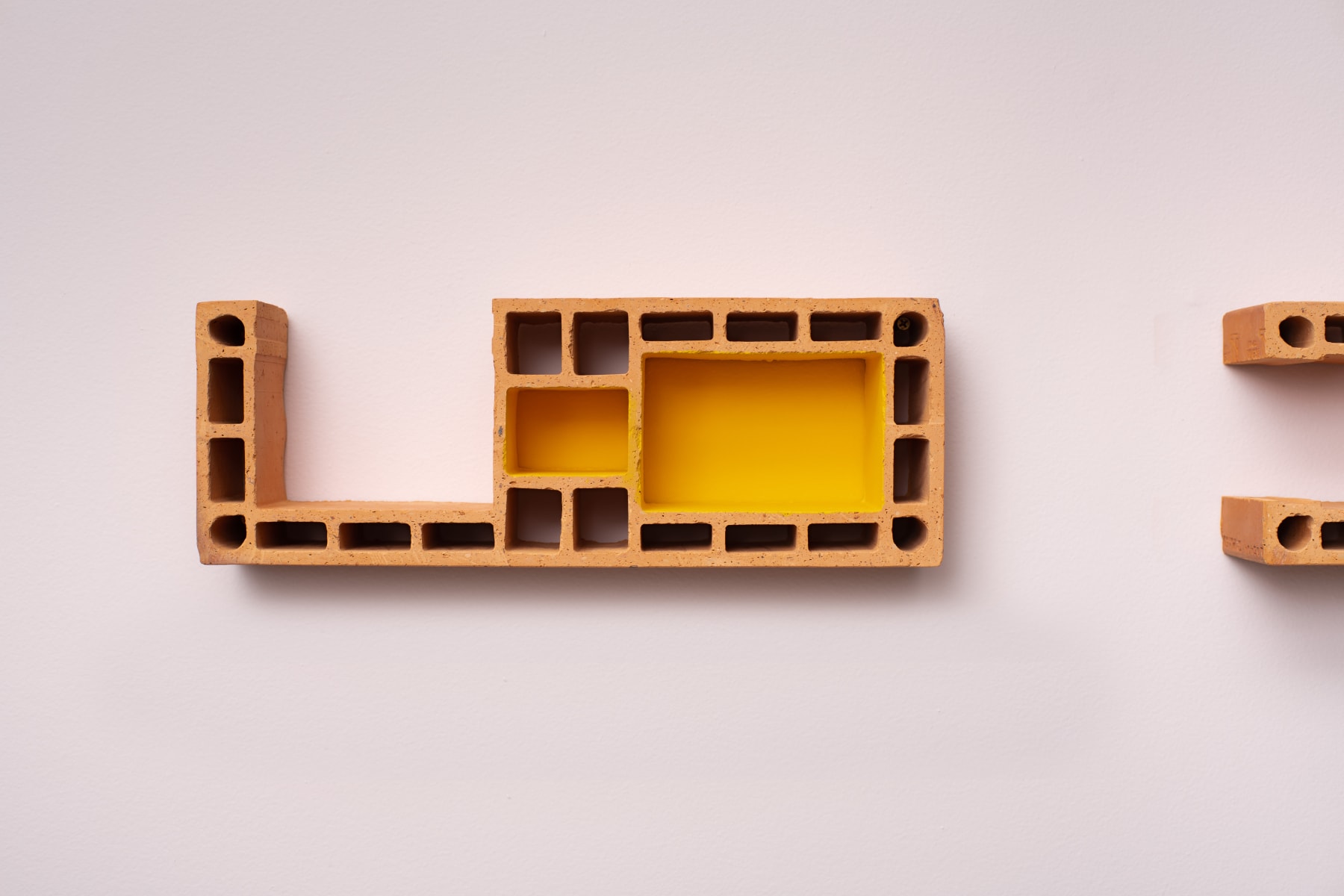-
Héctor Zamora
Bloco Furo Vertical 14 - Deus-Sol, 2022tinta acrílica a base de água sobre blocos de cerâmica
acrylic water-based paint on ceramic blocks69,4 x 201 x 10 cm
27.32 x 79.13 x 3.94 ined 1/2 + 1 P.A.Further images
Héctor Zamora é mais conhecido por sua pesquisa que envolve espaços públicos e o ambiente construído. Em suas obras, o artista reinventa e redefine os espaços convencionais, sejam expositivos ou...Héctor Zamora é mais conhecido por sua pesquisa que envolve espaços públicos e o ambiente construído. Em suas obras, o artista reinventa e redefine os espaços convencionais, sejam expositivos ou não, gerando ruídos entre os significados de público e privado, exterior e interior, real e imaginário. Se, por um lado, a obra de Héctor Zamora lida com a herança estética e formal do Concretismo e outras vanguardas Latino Americanas, por outro, problematiza questões sociais e políticas relacionadas ao trabalho numa sociedade de consumo e à subversão de arquiteturas.Héctor Zamora tem formação em design gráfico e geometria estrutural. Suas principais mostras individuais: MAZ Museo de Arte de Zapopan, Zapopan, México (2024), Museu Marítimo de Ílhavo, Ílhavo, Portugal (2023), The Roof Garden Comission, MET-NY, EUA (2020), LABOR, Cidade do México (2019), Pavilhão Branco (Portugal, 2018), Museo de Arte Contemporáneo de Monterrey (México, 2017), Fundación RAC (Espanha, 2017), Palais de Tokyo (França, 2016), CCBB São Paulo (2016), Center for Contemporary Art (Los Angeles, EUA, 2013) e Itaú Cultural (São Paulo, 2010). Dentre as coletivas estão: Instituto Cultural de Mexico, França (2023), Desert X, Coachella Valley, Palm Springs, EUA (2023); 13a Bienal do Mercosul, Porto Alegre, Brasil (2022); 4th Mediterranean Biennial, Israel (2021); Hirshhorn Museum, EUA (2020); Centro Galego de Arte Contemporánea, México (2018); Shanghai Biennial, China (2018); MAM-RJ, Brasil (2014); Guggenheim Museum, EUA, (2013), Museo de Arte de Lima, Peru (2012), 54ª Bienal de Veneza, Itália (2011); 11ª e a 14ª Bienal de Lyon, França (2011 e 2017); 12th International Cairo Biennale, Egito (2010), 9ª e 12ª edições da Bienal de la Habana, Cuba (2006 e 2015); 27ª Bienal de São Paulo, Brasil (2006). Zamora foi ainda contemplado com os prêmios do Graham Foundation Arquitetura + Arte (2011), The Garage Centre for Contemporary Culture (2009), The Pollock-Krasner Foundation (2007), Cisneros Fontanals Art Foundation (2006), Jumex Collection Foundation (2006), etc. Suas obras fazem parte das coleções do Amparo Museum (México), Fundación RAC (Espanha), Hirshhorm Museum and Sculpture Garden (EUA), dentre outros.Héctor Zamora is better known for his research, which involves public spaces and the built environment. In his works, the artist reinvents and redefines conventional spaces – exhibition spaces or others – giving rise to noise between the meanings of public and private, exterior and interior, real and imaginary. If, on the one hand, Héctor Zamora’s work deals with the aesthetic and formal legacy of concretism and other Latin American vanguard movements, on the other, it problematizes social and political questions related to work in a consumer society and to the subversion of architectures, of the city, and of history.
Héctor holds a degree in graphic design and structural geometry. He has held solo shows at prominent institutions which include MAZ Museo de Arte de Zapopan, Zapopan, Mexico (2024), Museu Marítimo de Ílhavo, Ílhavo, Portugal (2023), The Roof Garden Commission, MET NY, USA (2020); LABOR, Mexico City (2019); Pavilhão Branco (Portugal, 2018); the Museo de Arte Contemporáneo de Monterrey (Mexico, 2017); Fundación RAC (Spain, 2017); the Palais de Tokyo (Spain, 2016); CCBB São Paulo (2016), the Center for Contemporary Art (Los Angeles, USA, 2013) and Itaú Cultural (São Paulo, 2010). He has participated in group shows at venues that include the Instituto Cultural de Mexico, France (2023), Desert X, Coachella Valley Palm Springs, USA (2023); 13th Mercosul Biennial (2022), 4th Mediterranean Biennial, Israel (2021); Hirshhorn Museum, USA (2020); the Centro Galego de Arte Contemporánea, Spain (2018); the 12th Shanghai Biennale, China (2018); MAM-RJ (2014); Guggenheim Museum (USA, 2013); the Museo de Arte de Lima (Peru, 2012); the 54th Venice Biennale (Italy, 2011); the 11th and 14th editions of the Biennale de Lyon (2011 and 2017); the 12th International Cairo Biennale (Egypt, 2010); the 9th and 12th editions of the Bienal de la Habana (2006 and 2015); and the 27th Bienal de São Paulo (2006). Zamora has moreover been awarded prizes from the Graham Foundation Arquitetura + Arte (2011), the Garage Centre for Contemporary Culture (2009), the Pollock-Krasner Foundation (2007), the Cisneros Fontanals Art Foundation (2006), the Jumex Collection Foundation (2006), and others. His works figure in collections of important institutions such as Amparo Museum (Mexico), Fundación RAC (Spain), and Hirshhorn Museum and Sculpture Garden (USA).





